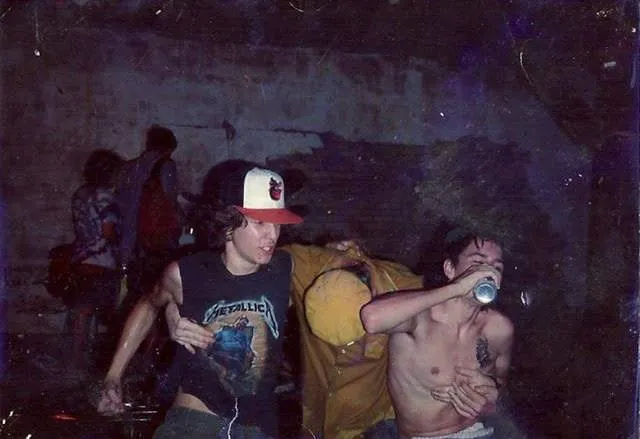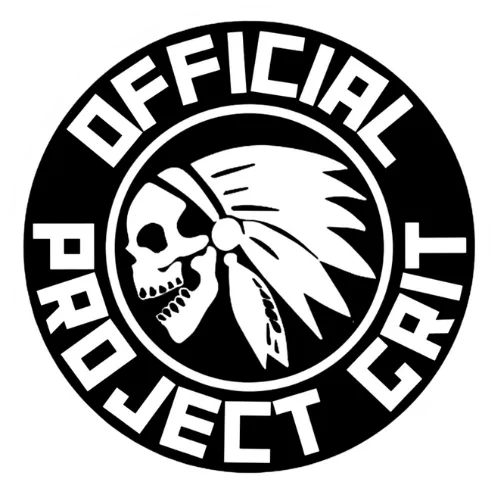
From Addiction to Endurance: The Origin Story of Official Project Grit
Every movement has an origin story.
For Official Project Grit, it didn’t begin in a gym or with a business plan. It began on the streets, at rock bottom, with a mentor who refused to let me quit on myself. This is my story.
From the Gutter
I wasn’t supposed to make it this far. For years, heroin owned me. Addiction stripped me down to nothing: no home, no purpose, no future. Nights blurred into days on the streets. Every choice I made dug the hole deeper. I wasn’t living, I was surviving, if you could even call it that.
I don’t need to tell another war story from the streets. If you’ve been there, you already know. We all have our own version of how we got there, and most of those stories start the same way, broken homes and broken hearts. My story was no different. A few injuries before high school introduced me to prescription drugs. Not long after, my dad left us. My mom was working three jobs to keep three kids fed, and life was about survival from the start.
But I also carried another inheritance. I’m an eighth-generation Texan. After my dad left, my grandfather became my world. He was a cattle rancher in South Texas, on land as unforgiving as the man himself: dust, cactus, snakes, scorpions, and no room for weakness. He was my rock but hard-edged, tough and ornery. A South Texas cattleman through and through.
Every summer I worked alongside him on the ranch, learning what his version of grit really meant: long days, blistering heat, no excuses. He loved his grandsons fiercely and showed us that you never back down and you never quit.
When a stroke took away his independence I watched the strongest man I knew become helpless, and it shook me to my core. By then the drugs had their hooks in me.The loss of my father figure, the ache of a broken home, and the pull of the fast lane surrounded by others with the same story lit the fuse. Before I was old enough to drive, I was off to the races.
Hopelessness doesn’t come all at once. It seeps in slowly until one day you wake up and realize there’s nothing left. I was a ghost with a heartbeat, and I had been desperately looking for a way out for years.
Enter Kenny
That’s when I met Kenny. He wasn’t the kind of man you could ignore. Tattoos covered his arms and neck, with TRY ME stamped across his throat like a permanent dare to the world. He carried himself with a presence that said he’d been through fire and walked out harder. But underneath that rough edge was something I hadn’t seen before, a man who had wasted years of his life and somehow turned it all around. He carried the grit I had buried, and he refused to let me quit on myself.
Kenny had lived his own hard story, a bank robber who did years in Leavenworth. He wasn’t soft, and he wasn’t pretending. But the man I met wasn’t some outlaw caricature. By the time our paths crossed, Kenny was a changed man. He knew what it meant to waste your life and how to turn it around. I could see that something was working for him, and I knew I needed what he had.
Kenny didn’t preach at me, he led by example. Excuses didn’t matter to him. What he carried was a way of seeing the world that cut through the noise. He believed in leaning into discomfort, taking responsibility, and finding purpose in struggle. More than anything, he believed in showing others how to do the same, and he lived it. Serving others was his top priority.
I was at my lowest when Kenny reached back into the gutter and pulled me up. He didn’t carry me, he walked beside me until I could stand. That’s what saved me.
The Compass He Gave Me
We started in the gym, training the body with lifting and boxing. In conversation, he challenged my thinking and pushed my mind past excuses. He spoke about faith and purpose in a way that stirred my spirit. And when I was broken, he helped me face emotions I had always tried to numb.
Those lessons gave me a foundation I had never known. They became the compass that kept me on the path of recovery.
For the first time in my life, I wasn’t just surviving day to day. I was building something that felt real.
But after several years of walking beside me in sobriety, cancer took Kenny. Losing him felt like the ground dropped out from under me. He had been my rock, the one man who had both sharpened me and believed in me when no one else did. With him gone, I carried the compass he’d given me, but I no longer had the steady hand pointing me toward it. His absence left a silence that no one else could fill.
The Slow Drift into Mediocrity
I’ll never forget where I was when I found out Kenny had died. I was in Colorado, up in the mountains. It was the Fourth of July, and out of nowhere it started snowing. I was stunned by the news, and I didn’t know what to do with the weight of it. For some reason, I just took off running.
I hated running. Always had. But I heard Kenny’s voice in my head, that same voice that never let me hide from the things I wanted to avoid. In that moment, the thing I hated was running, so I leaned straight into it. I kept going, and with every step I felt like I was facing not just the snow or the mountain, but the loss of my mentor.
That moment sparked something in me. I decided that if I hated running that much, then I needed to run farther. So I signed up for an ultra-distance marathon-my first was a 50K-and that choice snowballed into a love for endurance. Just me, long miles, and time to consider the lessons I’d learned.
But eventually, even that edge dulled. The miles added up, but so did the ease of it all. I had a home, a family, two dogs, and a couple of vintage trucks parked in the driveway. On the outside, it was everything I thought I wanted. On the inside, I was restless. The warm blanket of mediocrity had settled over me. What I didn’t see at the time was that I was missing two things Kenny always lived by: service to others and the power of community. It was time to dig deep again.
Gonzales, Texas
One weekend, I took my son to Gonzales, Texas, to show him a piece of history. That’s where we learned about the Immortal 32, thirty-two men who marched 75 miles from Gonzales to the Alamo in 1836, knowing they wouldn’t be coming back. They went anyway.
That story hit me like a bolt of lightning. I had been searching for my next hard thing, and right in front of me was the path of men who had marched into certain death, side by side, as brothers, protectors, and fighters. No ease, no mediocrity, no looking for a way out, just unquestionable purpose. I didn’t know if I could make it 75 miles, but I knew I couldn’t ignore the call to try.
So, I pitched the idea of re-tracing the 75 miles of the Immortal 32 to a friend. I told him, “Let’s try this crazy thing,” and without hesitation he just said, “That’s a horrible idea. What time?” That was it. The "plan" was set.
Year One: Mile 42 of 75
The first year neither of us really knew what we were stepping into. We hadn’t trained right and we didn’t have a real plan, but we were stubborn enough to try.
At mile 42, after hours on our feet with semi-trucks screaming past us in the dark, my partner hit a wall. He was down, broken, ready to quit. I was annoyed, angry, ready to leave him behind and prove I could finish alone.
But something bigger than me stopped me in my tracks. In that moment, I saw myself years earlier, strung out and left for dead. I saw Kenny turning back to pull me out of the gutter. That memory broke me open. I couldn’t walk away.
I turned around, helped my friend to his feet, and we exchanged a few words of encouragement. That was all it took. Twenty-seven hours and countless hard-earned lessons later, we reached the Alamo-worn down, beat up, yet carrying a renewed spirit. That’s when it hit me: this wasn’t about feats of endurance. It wasn’t about stacking up hard miles to prove something. It was about resilience and community. About testing yourself so you could become strong enough to help someone else. About refusing to leave someone behind. That’s when Official Project Grit was born.
The Ripple Effect
The Immortal 32 Ruck became our flagship event, a 75-mile test of body, mind, and spirit. From that spark, we built more-Comanche Moon, Camino de Chimayó, Willow City and others-each one designed with the same purpose: to challenge mediocrity, embrace difficulty, and show the power of doing hard things in community.
Our events are team-based for a reason. When you share the weight, when you hit the wall and break through it together, something bigger happens. You don’t just come out stronger, you come out connected. And that connection doesn’t end when the miles do. After every event, the phone calls and messages start rolling in. People tell us about breakthroughs they had on the road, walls they tore down, or clarity they hadn’t felt in years. Some call it life-changing. Others say it reconnected them to something they thought they had lost, faith, family, courage, themselves.
That feedback is the fuel that keeps this fire burning. It reminds me that the hardships I went through, the addiction, the homelessness, the nights I shouldn’t have survived, weren’t wasted. They became the raw material for something greater. That’s the ripple effect of Official Project Grit: one person finds their strength, then passes it on. That’s why we keep rucking. That’s why the miles matter.
More Than Miles
What started as my journey out of addiction and a search for the next hard thing has become a movement. From the gutter of addiction to the long road to the Alamo, the story has always been the same: we are built for more.
